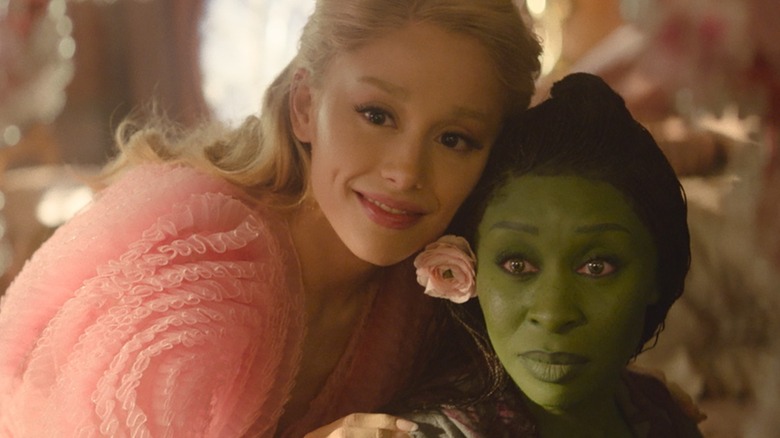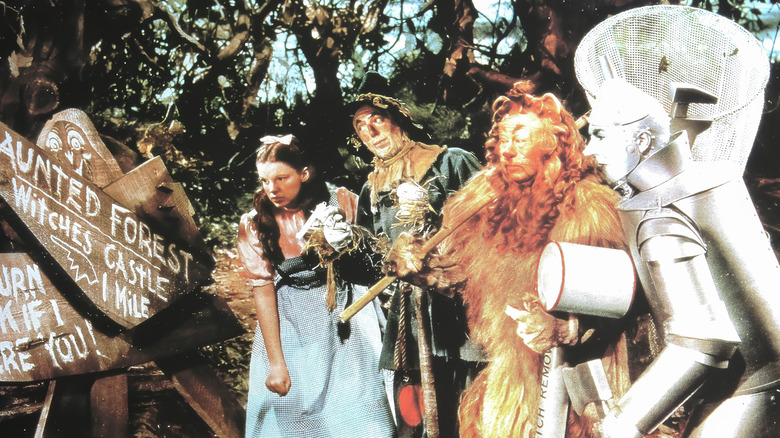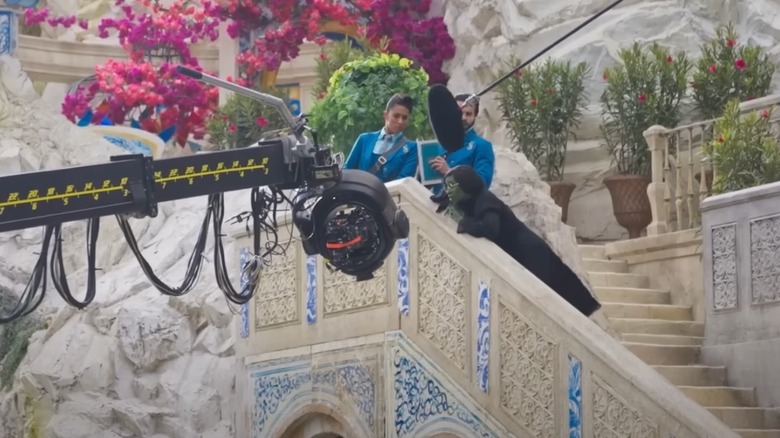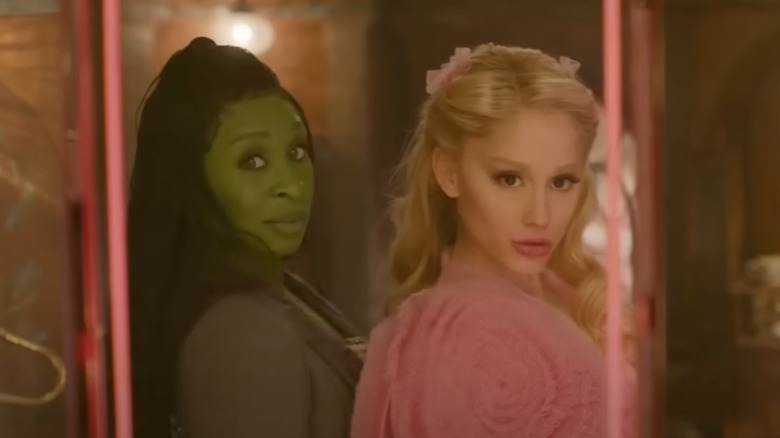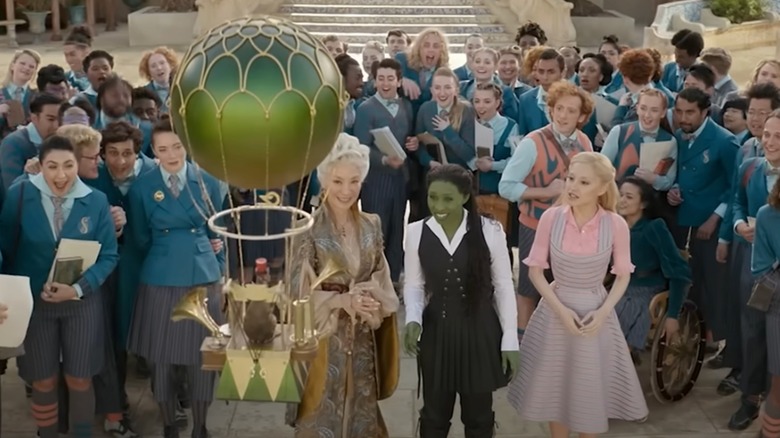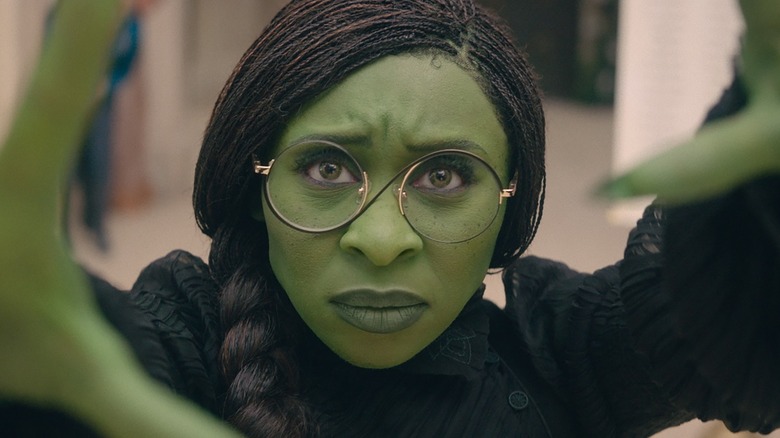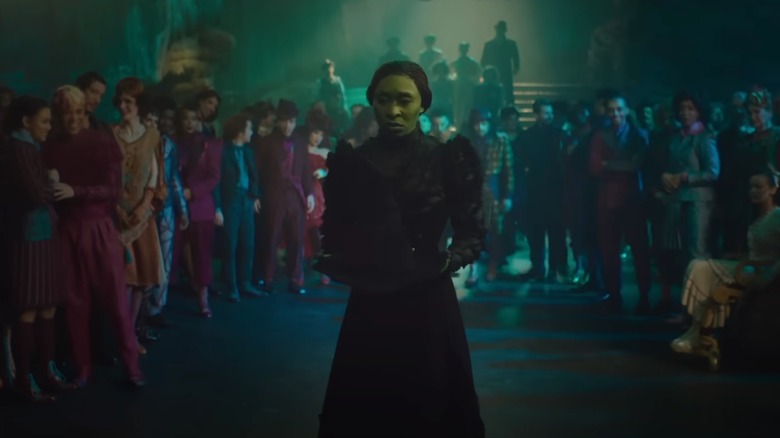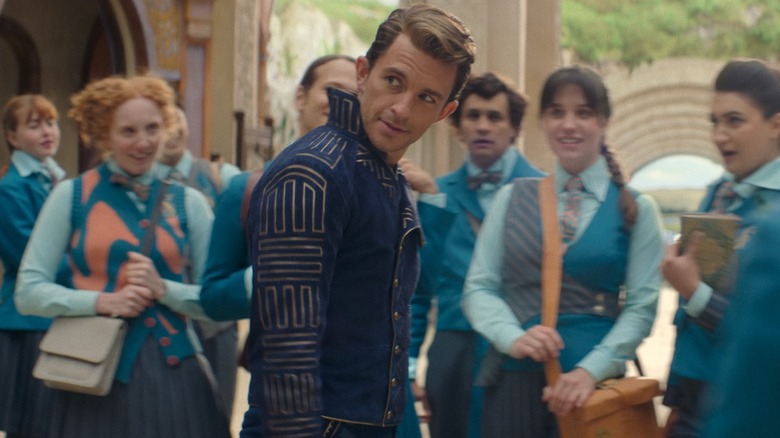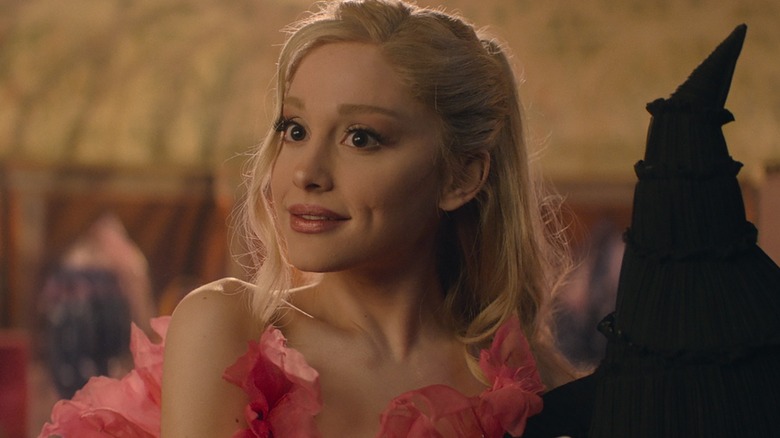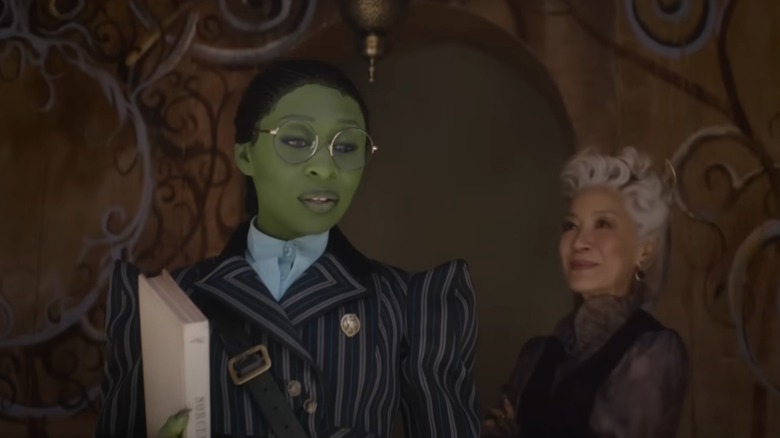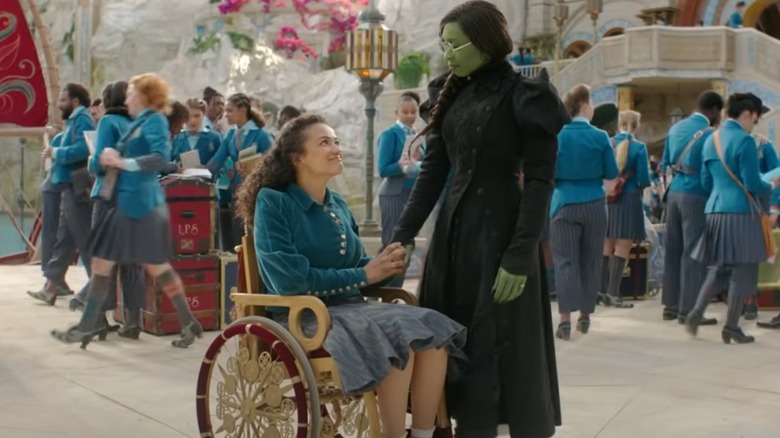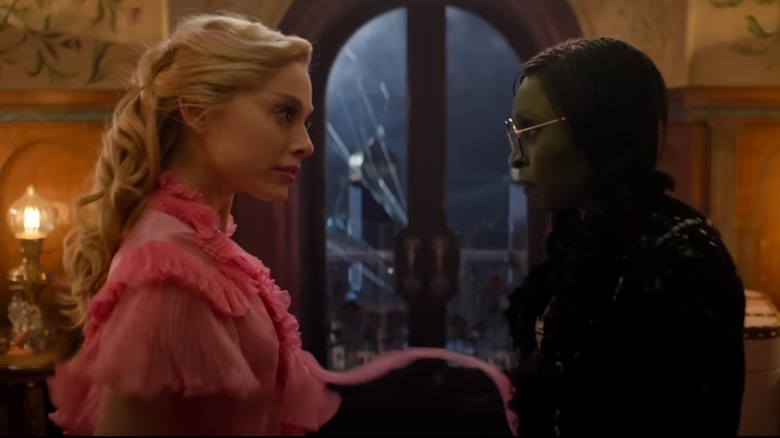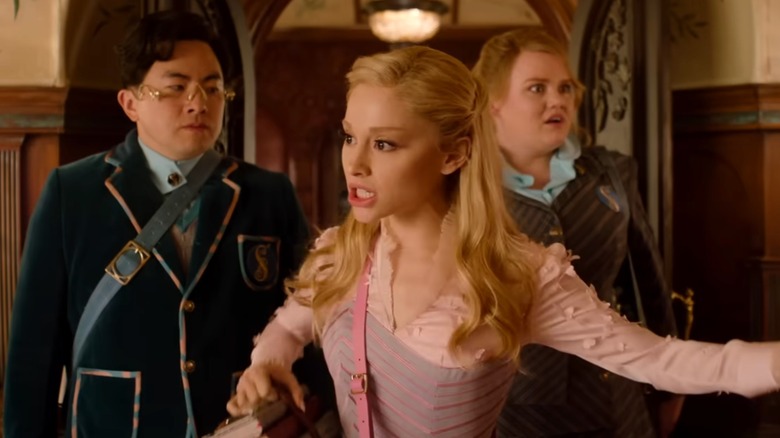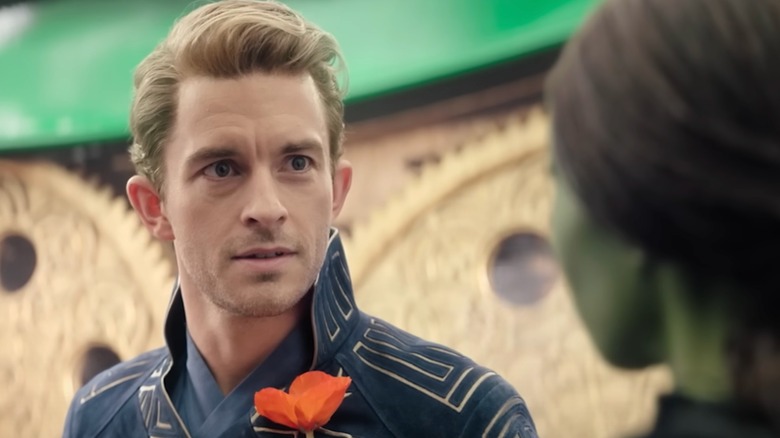Things Only Adults Notice About Wicked
"Wicked" has officially taken over all of our brains. The musical, based on the Broadway show, which is, in turn, based on the novel by Gregory Maguire, offers an alternative version of events to those shown in "The Wizard of Oz." We meet Elphaba played by Cynthia Erivo, who later becomes the Wicked Witch of the West, and Galinda played by Ariana Grande, who becomes Glinda the Good Witch, during their school days. Before they became the witches of Oz, the pair were unlikely friends at school.
Whether you're a fan of the show or you're new to the wonderful world of "Wicked" thanks to the film, it's safe to say, you've already fallen in love with Stephen Schwartz's epic score and with the iconic performances of Erivo and Grande. It's also likely that you spotted a few things about the story that you might not have noticed if you were a kid. Let's dive a little deeper into all of the things only adults notice about "Wicked."
Wicked the movie is filled with subtle references to The Wizard of Oz
Many older viewers of "Wicked" may pick up on some of the clever little nods to 1939's "The Wizard of Oz" that are peppered throughout the prequel. While some of these Easter eggs are fairly obvious — we see Dorothy, the Tin Man, Scarecrow, and Cowardly Lion walking down the Yellow Brick Road in the opening moments of the film, for instance — other references are a little more subtle.
One of the first references to "The Wizard of Oz" that you might spot is the title card — when the title, "Wicked: Part 1" appears on screen, it is written in the same font and style as the title card in the 1939 film. Then, there are the character Easter eggs. In "Wicked," Jonathan Bailey's Fiyero is destined to become the Scarecrow, while Ethan Slater's Boq will one day become the Tin Man. As many fans have noted, both Bailey and Slater pay homage to the physicality of the characters seen in the original film with their dance moves, mannerisms, movements. In one scene, Fiyero can be seen standing between two pillars with his arms stretched out like a scarecrow.
Other references include Elphaba riding on a bicycle with a basket (just like "The Wizard of Oz's" Miss. Gulch, the Kansas counterpart of the Wicked Witch), Elphaba and Glinda visiting the Emerald City salon (just like Dorothy and her friends in "The Wizard of Oz"), and Jeff Goldblum's Wizard of Oz peeking out from behind a curtain (just like the Wizard, aka the "man behind the curtain.")
The music in Wicked is full of Easter eggs
The visual Easter eggs aren't the only nods to "The Wizard of Oz" hidden in "Wicked" — in fact, subtle references were also woven into the score itself. As "Wicked's" composer Stephen Schwartz explained in a video for Classic FM, Elphaba's "Unlimited" theme, which appears in both "The Wizard and I" and the film's new version of "Defying Gravity," pays homage to the iconic "Somewhere Over the Rainbow" from "The Wizard of Oz."
Listen closely, and you may notice that the first seven notes of this theme are almost exactly the same as the chorus from the famous song — although they are, as Schwartz noted, "completely different rhythmically and harmonically." Even if you don't "know" music, he explained, you may be reminded of Dorothy's famous ballad as you listen to Elphaba's first big solo. "There is no more aspirational song that 'Somewhere Over the Rainbow,'" Schwartz said, but we think "The Wizard and I" might come in a close second.
There are loads of queer-coded undertones in Wicked
Most young viewers probably won't notice just how queer-coded the "Wicked" film is. As one writer noted for the Daily Beast, the movie "leans fully into its queerness." Not only is the film led by a cast of queer actors with Cynthia Erivo, Jonathan Bailey, Marissa Bode, and Bowen Yang, amongst others, the characters themselves are also queer-coded. Fiyero has a certain bisexual energy — his song "Dancing Through Life" sees him flirting with everyone from Glinda to the old librarian to a few male Shiz students.
The friendship between Glinda and Elphaba is also driven by an almost romantic energy, just as so many young female friendships can be. Even Ariana Grande admitted that her character may be a little queer. "Whether it's romantic or platonic, Glinda might be a little in the closet," she told Gay Times. "You never know. Give it a little more time. I mean, it is just a true love, and I think that transcends sexuality. It's just kind of a deep safety within each other. And that's why they probably ship it." Meanwhile, Erivo concurred, calling their relationship "true love."
Wicked is a timely political allegory
While "Wicked" may, on the surface, look a lot like a kids' film, at its heart, it's a story that deals with some pretty sophisticated and nuanced political ideas. By the end of the film, we learn that the Wizard poses as a benevolent, powerful leader when, in reality, he leads a corrupt political system that relies on misinformation and propaganda. Meanwhile, Elphaba, who is fighting for the victimized animals, is branded a liar and shunned by the Wizard's fanatic followers.
As many fans have noted, the premise could be compared to politics in America today. Even director Jon M. Chu has noted the similarities. "A charismatic leader who gaslights a community that this woman is wicked just because she's standing up for a marginalized group of people in the society, how could that be [political]?" Chu said to IndieWire.
Gregory Maguire, the author of the 1995 novel that inspired the musical, has also spoken about how the political undertones in the story of the witches of Oz have become even more timely over time. "The world has become more dangerous and despotism has become more apparent, not just in the Middle East but in Europe, and our own Western Hemisphere as well," he told Broadway World in 2020. "And so, it shocks me and saddens me that I think the story is more urgent now than it was 25 years ago."
Elphaba's backstory is actually pretty dark
The story of Elphaba's parentage and her early years aren't exactly kid-appropriate. In fact, many young viewers might miss out on just how dark her backstory really is. As Ariana Grande's Glinda reveals in the opening number, "No One Mourns the Wicked," Elphaba was actually the product of an affair — while her father, the Governor of Munchkinland, was away on business, a mysterious stranger paid a visit to her mother. He gave her a mysterious green elixir — which in the original novel is a date rape drug, by the way. "One thing led to another, as it so often does," says Glinda, before we cut to Elphaba's birth scene. The implication is, of course, that Elphaba was the daughter of this stranger and that she was born green because of the elixir. Chances are, this little hook-up scene will go over most young kids' heads.
In the second act of the show, it turns out that the mysterious stranger was the Wizard himself. Throughout the film, there are a few subtle hints of his true identity. For instance, during the Wizard's song "A Sentimental Man," he croons that he "always longed to be a father" while gazing into Elphaba's eyes. Even though he doesn't yet know that she's his daughter, fans might just pick up on this little Easter egg.
The Ozdust Ballroom is a complicated place
In the film version of "Wicked," the Ozdust Ballroom gets an edgy update. In the stage show, Glinda suggests the locale when Fiyero asks for the "most swankified place in town." However, in the film, the Ozdust is transformed into a "scandalocious" underground club. Fiyero comes up with the idea of heading to the club himself and Glinda replies, "Isn't it kind of illegal?"
Young viewers will understand this to be a club, but adult viewers will probably grasp the implication that, like the real speakeasies of the 1920s, it's a transgressive spot for the outcasts of society.
Speaking to Entertainment Weekly of the decision to change the Ozdust Ballroom for the film, director Jon M. Chu said, "Our conception of the Ozdust is very different than what we've seen on stage." He went on to explain that this version is closer to what is described in Gregory Maguire's novel. "We definitely wanted the underbelly of Oz," Chu said. "It's a place where animals all get to hang out, and there's an animal band. It's not prom. I always found that difficult to understand, like, 'Wait, is this dance sanctioned by the school? Then why is that rebellious?' In our version, Fiyero is sneaking them out of school to break the rules."
The cast is ... a little old
For many kids, adults are kind of all the same. In their eyes, there's little difference between 20 and 30 — which is a good thing for kids watching "Wicked." Because, let's face it, this the "Wicked" cast is ... a little old. The film follows Elphaba and Glinda in their university days. In other words, they're meant to be at least 18 years old at the start of the film. In reality, the pair were quite a bit older — Ariana Grande was 29 when filming began in December 2022 and Cynthia Erivo was 35. Other Shiz students were also quite a bit older than their characters — Jonathan Bailey was 34, while Bowen Yang was 32. While the casting kind of makes sense (the characters age quite a few years over the course of the musical), adult viewers are sure to notice that this university seems to be filled with 30-something year olds. As one fan wrote on Reddit, "I find most of the cast to be too old, and many of them look older than the characters' ages as well. I love Jonathan Bailey, but my god, he should be the Wizard of Oz." Another fan tweeted jokingly, "The students at Shiz University: Okay so there's a 40 year old man here and he's so hot."
Of course, "Wicked" is following in a proud movie musical tradition. After all, many of the best classic musicals featured some rather mature cast members. Who can forget the high school in "Grease" that was filled with 30-somethings?
Wicked doesn't exactly look as vibrant as its predecessor, The Wizard of Oz
While young fans of the "Wicked" film probably won't pay much attention to things like cinematography or color grading, some older viewers have already raised concerns about the film's palette, which as many have noted, doesn't have the magical vibrancy of the Technicolor world that "The Wizard of Oz" oozed. "The 'Wicked' movie sincerely looks like it has the worst color grading of any major movie in the last decade. Why is everything drab in f***ing Oz?" one film fan tweeted.
Director Jon M. Chu has since responded to such criticisms, explaining that desaturating the world of Oz was a creative choice. "I mean, there's color all over it," he told The Globe and Mail. "I think what we wanted to do was immerse people into Oz, to make it a real place. Because if it was a fake place, if it was a dream in someone's mind, then the real relationships and the stakes that these two girls are going through wouldn't feel real." Chu added that in his version of Oz, he wanted it to feel like a lived-in place rather than a fantasy land. "I want to feel the dirt. I want to feel the wear and tear of it. And that means it's not plastic."
Cynthia Erivo's casting marks an important moment for Black representation
For those who grew up as fans of "Wicked" the stage musical, Cynthia Erivo's casting as Elphaba will carry an additional layer of meaning. In the history of the stage musical, which premiered in 2003, Alexia Khadime is the only Black woman who has played Elphaba in a full-time capacity. For Black fans of the musical, seeing a Black actor take on the role offered a powerful and empowering moment of representation.
It's high time, too. After all, the role is about a person who is bullied and outcast because of the color of their skin. As Erivo told Variety, "I hope it's a bit of a love letter to everyone who feels different, who feels out of place, to all of the Black women who have walked into rooms and felt like they haven't been welcomed."
In fact, as Erivo told Unbothered, per Refinery29, she was careful to ensure Elphaba maintained some of Erivo's Blackness by giving the character micro braids. "The braids were something that I really wanted from the very, very beginning because I knew that I wanted to make sure that I was infused in this woman who was also green," she said. "I didn't want to erase everything about myself."
Nessarose's story is also more nuanced and carefully told in the film
Older viewers are also likely to note the importance of Marissa Bode's casting as Nessarose — she is the first wheelchair-using actor to take on the role of Elphaba's younger sister. Bode's casting lends a new layer to the character. Viewers may see her story from a new perspective. The film draws attention to the way Nessarose is often infantilized by those around her. Elphaba is portrayed as the only person to recognize Nessarose's desire for independence. In one notable scene (an addition from the original stage show), Miss Coddle pushes Nessarose's chair away from Elphaba despite her protests.
Since the film's release, Bode has taken to social media to share her thoughts on some viewers' responses to her character. "Representation is important but that's not the only thing that will save the disabled community," she said in a TikTok video. "I need a lot of y'all (non-disabled people) to do the work." She went on to explain that a lot of fans of the film hadn't liked the character. "'Wicked' and these characters and the movie wouldn't be what it was if there weren't different opinions on the characters and who's truly wicked or not," she said. "And not liking Nessa herself is okay. Because she is fictional, that's totally fine." However, she added, making "aggressive comments and jokes about Nessa's disability itself" was not.
The friendship between Elphaba and Glinda hits differently for adults
Most adult "Wicked" fans will probably agree — you have to go through the all-encompassing passion of young female friendship to really "get" the love that exists between Glinda and Elphaba. As one writer explained in an essay for The Berkeley Beacon, she first saw the musical as a girl — and back then, she didn't fully understand just how important her young friendships would be when she grew up. "'Wicked,' although very whimsical, exemplifies the core importance of female friendships, something so valuable to the womanhood that comes later," she wrote. As in "Wicked," the writer realized that her passionate young female friendships had been the relationships that helped to push her and support her as she entered adulthood — and when she saw the film as a woman, she explained it "brought all these emotions to the surface."
The writer's experience will be one that many adult "Wicked" fans can relate to. While Glinda and Elphaba's friendship may be endearing for young viewers, it just hits different once you're all grown up.
There are some potential timeline issues
Young viewers are likely to simply accept the timeline of "Wicked" as it's presented to us. But older fans may find themselves second guessing whether this timeline actually makes sense. Let's break it down: Elphaba is around 21 years old and Glinda is approximately 18 when they begin studying at Shiz University. By the end of the film, Elphaba has gone through an entire enemies-to-friends arc with Glinda, has learned magic, fell in love with Fiyero, discovered the secret persecution of the animals, met the Wizard, and has been branded Oz's Wicked Witch. A lot happens. But the events of the film kind of seem to take only a matter of months — maybe a year at most. In fact, certain events are only days apart (just take the Ozdust Ballroom, which evidently occurs in the same 24 hours as Elphaba and Fiyero's rescue of the Lion Cub). Many grown-up viewers may find it hard to accept this bizarrely quick timeline.
Things will, undoubtedly, only get more confusing in "Part Two." Dorothy is thought to land in Oz around five to 10 years after the beginning of "Wicked: Part One" — and based on how quickly events unfold in Act Two of the stage show, the more you think about the timeline of "Wicked," the less it makes sense. Luckily, most kids probably won't be too bothered by it.
The love triangle in Wicked is actually pretty heartbreaking
The emotional heart of "Wicked" is the friendship between Elphaba and Glinda — which, by "Part Two," will be threatened not only by their divergent political paths, but also by their love for Fiyero. In the first film, Glinda begins dating Fiyero while Elphaba finds herself drawn to him, even though, as she puts it, she's "not that girl."
Only grown-up fans of the film will fully grasp the emotional complexity of this thorny love triangle. Only adults will know the complicated pangs of feeling unrequited love for your best friend's partner. Or, the even more complicated feeling of realizing the person you love can never love you the way they love someone else. Adults will also realize that this is not a simplistic love triangle where only one pairing makes sense — instead, Fiyero has genuine connections with both Glinda and Elphaba. Many grown-up viewers may even find themselves wishing all three could embrace their feelings for each other — at the same time. "None of these relationships are bad, toxic, or even ill-advised," wrote one fan for Cosmopolitan. "Ultimately, why make Fiyero, or Elphaba or Glinda for that matter, take sides? They would be an iconic throuple."
